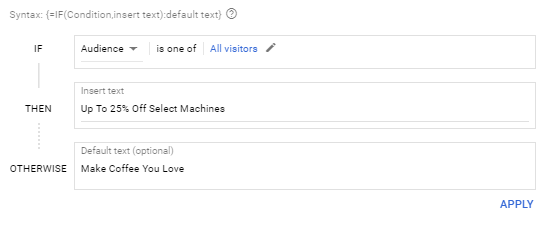October 8, 2021
The Ideal QA Process in Digital Advertising
In 2017, Google rolled out IF functionality for ad copy, giving advertisers the opportunity to customize their messaging based on device or audience. Now, instead of breaking out campaigns to target and message different types of traffic, advertisers can tweak their ad copy to speak to these audiences within the same campaigns.
Let’s look at an experiment on Google IF Function audience ads for an ecommerce client. Unfortunately, advertisers are still unable to segment IF reporting by audience. As a result, you cannot see which Google audience, and therefore which version of ad copy, is generating the traffic. You can, however, look at IF ad performance compared to regular ETAs to see how the two versions compare. This experiment saw regular ETAs outperform the IF ads (for now!), however, here’s some tips, takeaways and next steps along the way to help make your IF ads a success.
To test IF ads, we used Google remarketing audiences for an ecommerce client that sells espresso machines, coffee machines, coffee accessories and beans. The basic hypothesis: Would users on the “All Visitors” list (users who visited the site at least once) be more likely to purchase if, after performing a new search, they saw an ad suggesting there might be a discount on their product of interest? With this in mind, we set up ads across brand and nonbrand ad groups, using the copy below for an H2. H1’s closely matched the ad group theme, while descriptions were kept generic with a CTA of “Start Making A Better Cup Of Coffee.” The experiment collected data for a month and a half.

As you can see below, IF ads generated a better CTR, but ETAs outperformed them on nearly every other metric. Yes, it’s true that the IF ads have brand new copy and are being compared to ads that have the benefit of months of run time as well as Metric Theory’s and Google’s algorithmic optimizations.

However, seeing that the ads aren’t working, chalking it up to factors outside of your control, and pausing the ads doesn’t get anyone very far! Below are the next steps I am using to improve upon v1 of IF ads. Consider these before launching your first test to save time and receive better results.
To gain significant volume for the test, we applied ads to almost all nonbrand and brand search ad groups. You’ll notice however, that the same generic sale copy was applied to all machine brands, types, sizes, etc. Further, because products go on and off sale at different times, there was a chance that the product a user searched for wasn’t even on sale at that moment. Working with your client to better understand promotional schedules will help you further target and optimize IF ads with specific messaging.
Consider testing out Google Similar Audiences. Try these out if you are looking for more of a prospecting than remarketing strategy.
Don’t forget that IF ads work on device type, as well. Notice that mobile performance is lacking? Test out an IF ad with a mobile specific offer or mobile-focused ad copy to see if you can capture that lead before the user moves to a desktop.
Google IF Function ads are a great way to tailor your messaging to specific audiences. Showing users that you are aware they’ve interacted with your brand before or are using a specific device to search can go a long way towards capturing your next customer. As digital moves to targeting “Segments of One”, the more you address specific audiences with specific messaging, the better.
If you’re looking for help on further customizing your messaging, contact our team!
